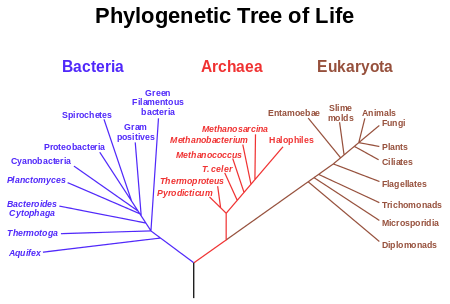Domain (biology)
_crop.jpg)
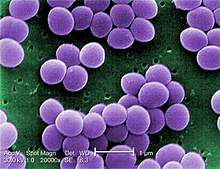
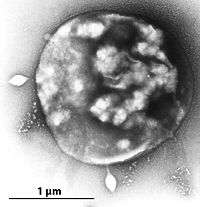
Eukaryota (represented by the Australian green tree frog, left), Bacteria (represented by Staphylococcus aureus, middle) and
Archaea (represented by Sulfolobus, right).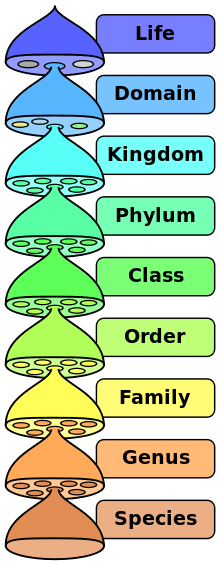
In biological taxonomy, a domain (Latin: regio[1]), also superkingdom or empire,[2] is the highest taxonomic rank of organisms in the three-domain system of taxonomy designed by Carl Woese, an American microbiologist and biophysicist. According to the Woese system, introduced in 1990, the tree of life consists of three domains: Archaea, Bacteria, and Eukarya.[1] The first two are all prokaryotic microorganisms, or single-celled organisms whose cells have no nucleus. All life that has a nucleus and membrane-bound organelles, and multicellular organisms, is included in the Eukarya.
Domain or dominion
The term "domain" was proposed by Woese et al. (1990) in his three-domain system. This term represents a synonym for the category of dominion (Lat. dominium), introduced by Moore in 1974.[3] However, only Stefan Luketa uses the term "dominion".[4] He created two additional domains ("dominions") for Prions and Viruses.
Characteristics of the three domains

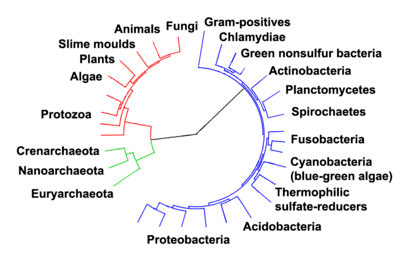
Each of these three domains contains unique rRNA. This forms the basis of the three-domain system. While the presence of a nuclear membrane differentiates the Eukarya from the Archaea and Bacteria, both of which lack a nuclear membrane, distinct biochemical and RNA markers differentiate the Archaea and Bacteria from each other.
Archaea
Archaea are prokaryotic cells, typically characterized by membrane lipids that are branched hydrocarbon chains attached to glycerol by ether linkages. The presence of these other linkages in Archaea adds to their ability to withstand extreme temperatures and highly acidic conditions, but many archea live in mild environments. Halophiles, organisms that thrive in highly salty environments, and hyperthermophiles, organisms that thrive in extremely hot environments, are examples of Archaea.
Archaea evolved many cell sizes, but all are relatively small. Their size ranges from 0.1 μm to 15 μm diameter and up to 200 μm long. They are about the size of bacteria, or similar in size to the mitochondria found in a eukaryotic cells. Members of the genus Thermoplasma are the smallest of the archaea.
Bacteria
Even though bacteria are prokaryotic cells just like Archaea, their membranes are made of unbranched fatty acid chains attached to glycerol by ester linkages. Cyanobacteria and mycoplasmas are two examples of bacteria. They characteristically do not have ether linkages like Archaea, and they are grouped into a different category—and hence a different domain. There is a great deal of diversity in this domain. Confounded by that diversity and horizontal gene transfer, it is next to impossible to determine how many species of bacteria exist on the planet, or to organize them in a tree-structure, without cross-connections between branches.
Eukarya
Members of the domain Eukarya—called eukaryotes—have membrane-bound organelles (including a nucleus containing genetic material) and are represented by four kingdoms: Plantae, Protista, Animalia, and Fungi.
Exclusion of viruses and prions
None of the three domains in the three-domain system includes non-cellular life. As of 2011 there is talk about nucleocytoplasmic large DNA viruses possibly being a fourth branch domain of life, a view supported by researchers in 2012.[7]
Stefan Luketa proposed a five-domain system in 2012, adding Prionobiota (acellular and without nucleic acid) and Virobiota (acellular but with nucleic acid) to the traditional three domains.[4]
Alternative classifications
Alternative classifications of life include:
- The two-empire system or superdomain system, with top-level groupings of Prokaryota (or Monera) and Eukaryota.[8][9]
- The eocyte hypothesis, first proposed by James A. Lake et al. in 1984, which posits two domains (Bacteria and Archaea, with Eukaryota included in Archaea).[10][11][12]
See also
- Biological dark matter
- Neomura, which is the two domains of life of Archaea and Eukaryota
- Phylogenetics
- Protein structure
- Systematics
- Three-domain system
References
- 1 2 Woese C, Kandler O, Wheelis M (1990). "Towards a natural system of organisms: proposal for the domains Archaea, Bacteria, and Eucarya". Proc Natl Acad Sci USA. 87 (12): 4576–9. Bibcode:1990PNAS...87.4576W. doi:10.1073/pnas.87.12.4576. PMC 54159. PMID 2112744. Retrieved 11 February 2010.
- ↑ "The Scientific Taxonomy and Classification of all Creatures". Retrieved 19 October 2015.
- ↑ Moore R. T. (1974). "Proposal for the recognition of super ranks" (PDF). Taxon. 23 (4): 650–652. doi:10.2307/1218807.
- 1 2 Luketa S. (2012). "New views on the megaclassification of life" (PDF). Protistology. 7 (4): 218–237.
- ↑ Cox, C. J.; Foster, P. G.; Hirt, R. P.; Harris, S. R.; Embley, T. M. (2008). "The archaebacterial origin of eukaryotes". Proc Natl Acad Sci USA. 105 (51): 20356–61. Bibcode:2008PNAS..10520356C. doi:10.1073/pnas.0810647105. PMC 2629343. PMID 19073919.
- ↑ Ciccarelli FD, Doerks T, von Mering C, Creevey CJ, Snel B, Bork P (2006). "Toward automatic reconstruction of a highly resolved tree of life" (PDF). Science. 311 (5765): 1283–7. Bibcode:2006Sci...311.1283C. doi:10.1126/science.1123061. PMID 16513982.
- ↑ Nasir, A; Kim, KM; Caetano-Anolles, G (2012). "Giant viruses coexisted with the cellular ancestors and represent a distinct supergroup along with superkingdoms Archaea, Bacteria, and Eukarya". BMC Evol. Biol. 12: 156. doi:10.1186/1471-2148-12-156. PMC 3570343. PMID 22920653.
- ↑ Mayr, Ernst (1998). "Two empires or three?". PNAS. 95 (17): 9720–9723. Bibcode:1998PNAS...95.9720M. doi:10.1073/pnas.95.17.9720. PMC 33883. PMID 9707542. Retrieved 5 September 2011.
- ↑ Cavalier-Smith, T. (2004). "Only six kingdoms of life" (PDF). Proc. R. Soc. Lond. B. 271 (1545): 1251–1262. doi:10.1098/rspb.2004.2705. PMC 1691724. PMID 15306349. Retrieved 2010-04-29.
- ↑ Archibald, John M. (23 December 2008). "The eocyte hypothesis and the origin of eukaryotic cells". PNAS. 105 (51): 20049–20050. Bibcode:2008PNAS..10520049A. doi:10.1073/pnas.0811118106. PMC 2629348.
- ↑ Lake, James A.; Henderson, Eric; Oakes, Melanie; Clark, Michael W. (June 1984). "Eocytes: A new ribosome structure indicates a kingdom with a close relationship to eukaryotes". PNAS. 81 (12): 3786–3790. Bibcode:1984PNAS...81.3786L. doi:10.1073/pnas.81.12.3786. PMC 345305. PMID 6587394.
- ↑ Williams, Tom A.; Foster, Peter G.; Cox, Cymon J.; Embley, T. Martin (December 2013). "An archaeal origin of eukaryotes supports only two primary domains of life". Nature. 504 (7479): 231–236. Bibcode:2013Natur.504..231W. doi:10.1038/nature12779. PMID 24336283.
